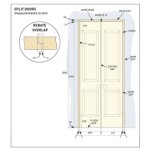Decoding Chevy Silverado Interior Color Codes: A Comprehensive Guide
The Chevrolet Silverado, a mainstay in the pickup truck market, offers a range of interior color options that allow owners to personalize their vehicles. These interior colors are not simply chosen at random; they are assigned specific color codes that dealerships, parts suppliers, and automotive enthusiasts use to accurately identify and order the correct components for repairs, customizations, or restorations. Understanding these color codes is crucial for ensuring a perfect match when replacing parts or making alterations to the interior of a Silverado. This article will provide a detailed guide to Chevy Silverado interior color codes, outlining their importance, decoding methods, and application in various scenarios.
The Significance of Interior Color Codes
Interior color codes are more than just labels; they are essential identifiers that streamline the process of maintaining and modifying a vehicle's interior. Without a standardized system, matching interior components would become a cumbersome and error-prone task. Imagine trying to replace a damaged seat cover or a cracked dashboard panel without knowing the exact color code. The chances of receiving a mismatched part would be significantly higher, leading to frustration and wasted resources.
These codes provide specific information beyond just the general color name. For example, what might be described as "gray" could encompass numerous subtle variations, each with its unique code. One variant might be a light, almost silver-gray, while another could be a darker, charcoal-gray. The corresponding color codes distinguish these subtle but important differences. This precision is particularly critical for interior components that are frequently exposed to sunlight, as slight color variations will become more apparent over time.
Furthermore, interior color codes are essential for maintaining the vehicle's original factory appearance. During repairs or restorations, using the correct color code ensures that the replacement parts seamlessly integrate with the existing interior, preserving the vehicle's aesthetic integrity and overall value. This is particularly important for classic or collectible Silverado models, where originality significantly contributes to the vehicle's worth.
For aftermarket companies that produce interior accessories, understanding these color codes is paramount. These companies rely on accurate color information to manufacture products that seamlessly blend with the existing interior of the Silverado. Floor mats, seat covers, steering wheel covers, and dashboard trims all require precise color matching to appeal to potential buyers and maintain a professional image.
Locating the Interior Color Code
The interior color code for a Chevy Silverado is typically found on the Service Parts Identification label, also known as the "SPID" label. This label contains a wealth of information about the vehicle's build specifications, including the paint code, options packages, and, of course, the interior color code. The location of the SPID label can vary depending on the Silverado model year, but it is commonly found in one of the following places:
*Glove Box:
This is perhaps the most common location. Open the glove box and check on the inside surface of the door or on the interior side walls of the glove box compartment. *Driver's Side Door Jamb:
Look on the door jamb of the driver's side door, often near the door latch. *Center Console:
On some models, the SPID label may be located inside the center console, either on the underside of the lid or on the interior walls.The SPID label is a rectangular sticker that contains a series of alphanumeric codes. Locating the interior color code among these can be slightly challenging, as the specific format varies from year to year. However, the interior color code is usually indicated by a three-digit or four-digit code, often preceded by the letters "INT. TRIM" or similar phrasing. The code itself represents a specific color palette and material combination used inside the vehicle. Always consult the vehicle's owner's manual or a trusted online resource for model-specific guidance if you are unsure about the proper identification of the interior trim code.
Once the SPID label is located, carefully examine the alphanumeric codes to identify the interior color code. The code will consist of a combination of numbers and letters. For example, an interior color code might resemble "12I" or "623." It is important to note down the entire code accurately to ensure that you are ordering the correct components. If you are unsure about the meaning of a specific code, consulting a Chevy Silverado parts catalog or an online database is highly recommended.
In cases where the SPID label is missing or illegible, there are alternative methods for identifying the interior color code. One approach involves contacting a local Chevy dealership's parts department. With the vehicle's Vehicle Identification Number (VIN), the dealership can access the vehicle's build records and provide the correct interior color code. The VIN is a unique 17-character identifier that is typically found on the dashboard (visible through the windshield), on the driver's side door jamb, and on the vehicle's registration and insurance documents.
Another option is to consult online forums and communities dedicated to Chevy Silverado enthusiasts. These online resources often contain a wealth of information about vehicle specifications, including interior color codes. By providing the vehicle's year, model, and a detailed description of the interior color, members of the community may be able to help identify the correct color code. It is crucial to verify any information obtained from online sources with a reputable parts supplier or a Chevy dealership to ensure its accuracy.
Decoding and Applying Interior Color Codes
Once the interior color code has been located, the next step is to understand its meaning and how it translates to specific interior components. Chevy Silverado interior color codes are typically associated with names that provide a general description of the color. For instance, code "12I" might correspond to "Medium Dark Pewter," while code "623" could represent "Neutral." These names offer a general understanding of the color, but the code itself is what provides the precise match.
The interior color code is used when ordering replacement parts or accessories for the vehicle's interior. This ensures an exact color match and maintains the vehicle's original appearance. When ordering seat covers, floor mats, dashboard trims, or any other interior component, it is crucial to provide the correct interior color code. The parts supplier will use this code to identify the precise color and material used in the original component, ensuring that the replacement blends seamlessly with the existing interior.
When undertaking interior customizations, the interior color code serves as a valuable reference point. By knowing the exact color of the existing interior, owners can select aftermarket components that complement or contrast with the original colors in a deliberate and aesthetically pleasing way. This allows for a more cohesive and professional-looking customization that enhances the overall appearance of the vehicle. Some owners use this information to carefully choose accent colors for stitching or trim pieces.
Interior color codes also play a critical role in vehicle restoration projects. When restoring a classic or vintage Chevy Silverado, maintaining the vehicle's original appearance is often a primary goal. The interior color code ensures that any replacement interior components are an exact match to the original color, preserving the vehicle's historical accuracy and value. This attention to detail is particularly important for collectors and enthusiasts who prize originality above all else.
In conclusion, understanding Chevy Silverado interior color codes is essential for maintaining, modifying, and restoring these popular pickup trucks. These codes provide a standardized system for identifying specific interior colors and materials, ensuring accurate matching of replacement parts and accessories. By locating the SPID label, identifying the interior color code, and understanding its meaning, owners can effectively manage the appearance and value of their vehicles.
Interior Trim Code Guide Seat Doctors
Interior Trim Color Chevy Silverado And Gmc Sierra Forum

1999 2002 Gm Interior Colors Rpo Trim Code Comparison Chevy Gmc Silverado Sierra Tahoe Suburban

Interior Upholstery Paint Gm Chevrolet 2024 66 Auto Color
Interior Color Code The 1947 Present Chevrolet Gmc Truck Message Board Network

How To Find Your Interior Rpo Trim Color Code On Gm Vehicle Glove Box Tag Label
Interior Color Code The 1947 Present Chevrolet Gmc Truck Message Board Network

2006 Interior Paint Codes How To Determine 1999 2024 Silverado Sierra 1500 Gm Trucks Com
Interior Trim Code Guide Seat Doctors
Interior Trim Code Guide Seat Doctors
Related Posts








